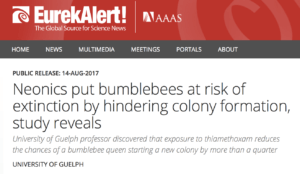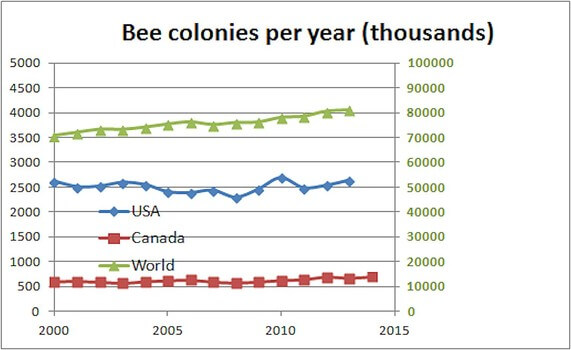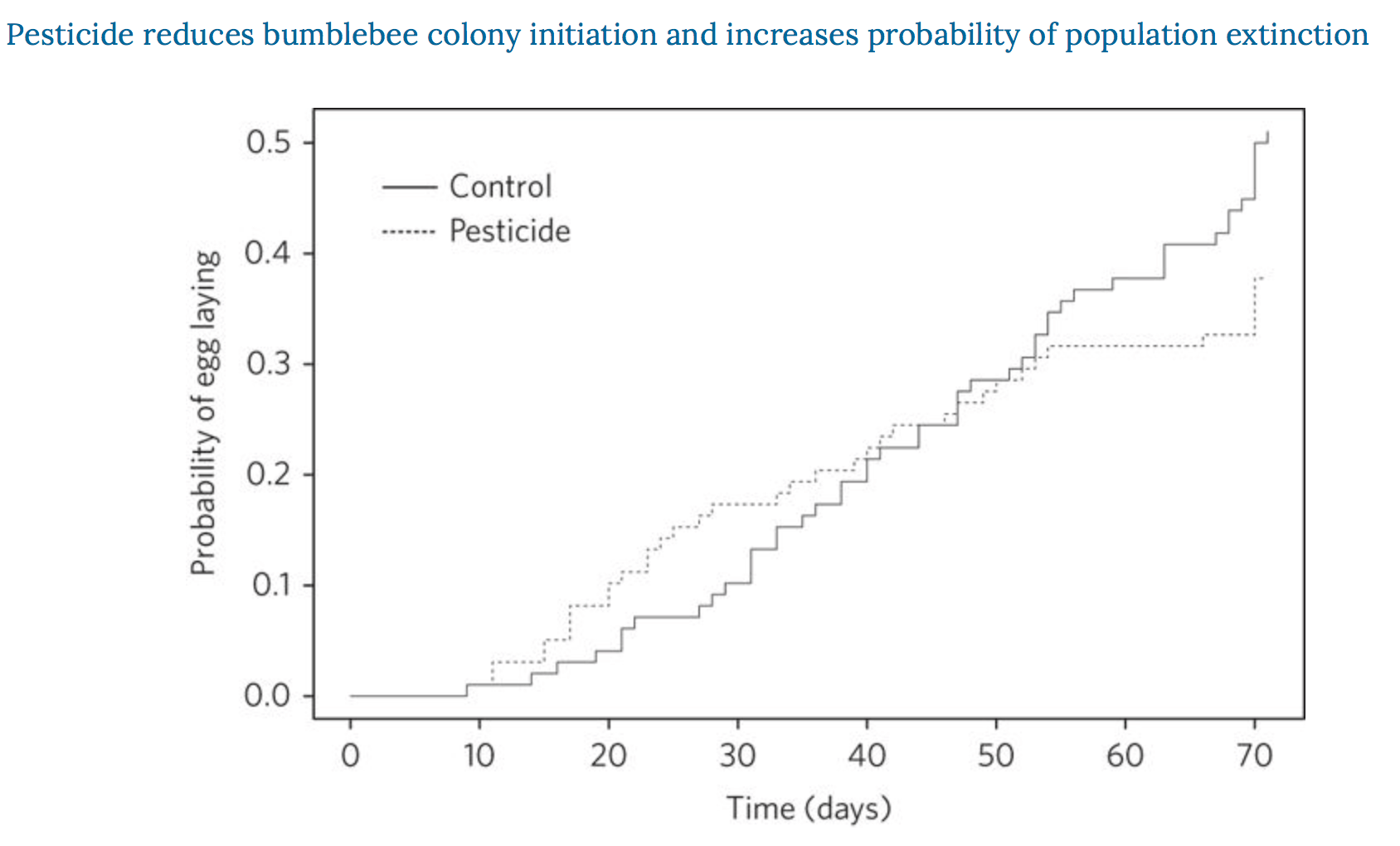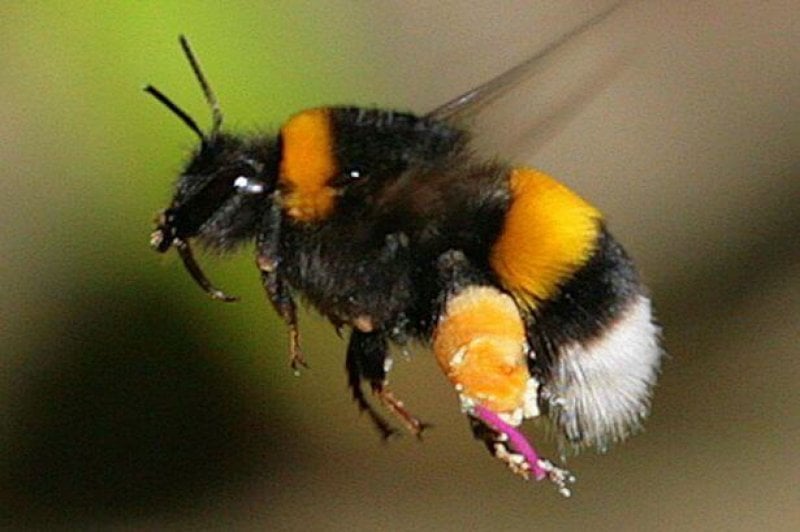Two studies on the health of bumblebees and links to neonicotinoid health were published simultaneously last month in sister publications of the prestigious science journal empire Nature.
Both examined closely similar scientific questions, with somewhat different experimental methodologies. But the study that found that neonics caused no serious issues was ignored by the media while the one suggesting a bee-apocalypse was widely played up as “definitive.’
Let’s unpack what these studies actually showed, and reflect on why the studies have been reported on so differently.
The studies were not identical in focus, although they had one author in common—entomologist Nigel Raine of the University of Guelph in Ontario. They looked at different stages in the life cycle of bumblebees and their queens. So, on that basis alone, the findings about the differences in bee health could have been different. But the issue here is not only the conclusions, but the reporting on the studies.
 One study—the one that suggested bumble queens might face mortal danger—was widely circulated. It reported, according to a press release by Guelph, that ‘neonics placed bumbles at the risk of extinction.
One study—the one that suggested bumble queens might face mortal danger—was widely circulated. It reported, according to a press release by Guelph, that ‘neonics placed bumbles at the risk of extinction.
“This study shows that neonicotinoids could be having a devastating effect on wild bumblebee populations,” Raine said. “We urgently need to know more about how pesticides could be affecting other species to make informed decisions about the risks associated with using these chemicals.”
It’s not hard to see why this study got intense media attention. Apocalyptic predictions grab headlines. Understandably, it generated a tremendous amount of scary news coverage. The media was all over it with literally dozens of stories in prestigious publications and it swamped social media.
Bee-apocalypse that never happened
 The title of the press release was apocalyptic. It also contradicts what we know about honeybees and neonics, a subject of intense scrutiny. For years, a minority of scientists and an overwhelming majority of reporters with little clue about the science, predicted the demise of honey bees—remember the now infamous 2013 Time cover story, A World Without Bees. Since then the opposite has happened. Honeybee colonies around the world are at all-time highs.
The title of the press release was apocalyptic. It also contradicts what we know about honeybees and neonics, a subject of intense scrutiny. For years, a minority of scientists and an overwhelming majority of reporters with little clue about the science, predicted the demise of honey bees—remember the now infamous 2013 Time cover story, A World Without Bees. Since then the opposite has happened. Honeybee colonies around the world are at all-time highs.
Environmental advocates, joined by some beekeepers and scientists, had already fingered a culprit for the presumed mass honeybee die-off. They blamed neonic pesticides for everything from Colony Collapse Disorder—a still-unexplained condition in which bees suddenly abandon their colonies that has come and gone over the last decade, just as it has many times in history—to recent years’ elevated over-winter honey bee colony losses.
Now we know that was a false, largely ideologically driven, alarm. It’s now widely understood that bee populations are at generational highs, rising in Europe and North America. With some setbacks, linked largely to cold winters and the lingering effects of CCD, they have been rising ever since neonics came on the market in the mid 1990s. There is no honeybee apocalypse on the horizon.
That’s not to say that all is rosy with the world bee population. There have been some spikes in the overwinter death rate beyond the 20% or so that is considered acceptable by beekeepers. And bees, which are treated like agricultural livestock by commercial beekeepers, do face unusual stressors.
But It’s become clear to most entomologists that the health problems afflicting honeybees are attributable to a complex set of factors, at the center of which is the ubiquitous and hard-to-combat Varroa destructor mite. The pest transmits and makes virulent up to a dozen viruses and diseases in honey bee colonies—and has been around in growing numbers since the 1980s.
Bumblebees near extinction study
But what about bumblebees? The focus of anti-pesticide campaigners shifted to bumblebees once it was clear that honeybees were not endangered. There is a huge volume of data, including many field studies, on honeybees, which show in real world conditions that honeybees are not endangered because of neonics. There is not so much research on bumblebees, however. These two recent studies were designed to begin to address that research gap.
Both studies addressed the effects of one neonicotinoid pesticide—thiamethoxam—on bumblebee colonies. Neither could be called ‘field realistic’. One focused on queens before they started laying eggs. The other targeted established colonies. Both exposed their target subjects to jugs of neonic laced syrup over many days—nothing like they would have experienced in real world conditions. And they came up with radically different conclusions as to the effect of the chemical, as interpreted by the researchers. Let’s dig deeper.
The queen study, led by Gemma Baron of the UK’s Royal Holloway University, exposed mated (fertilized) queen bees of Bombs terrestris—one of the most ubiquitous of the more than 250 known bumblebee species—to two weeks of laboratory feedings of sugar syrup spiked with what was claimed to be ‘field realistic’ concentrations of the neonic thiamethoxam (2.4 parts per billion). The result, they said, was a 26% reduction in the frequency of treated queens initiating a new colony by post-hibernation egg-laying. The reduction was said to be more pronounced after a long hibernation (12 weeks) rather than a short one (6 weeks)—even though a realistic hibernation would be more like 6-9 months! The study’s key finding was summarized in this graphic.
Effect of pesticide exposure on egg laying
This event history curve shows the cumulative probability of egg laying (from the end of hibernation (zero days) until the first egg was laid) by queens exposed to either the pesticide thiamethoxam or a control.
But look at the graph carefully, and notice the crossed lines near 50 days. The graph shows that queens exposed to thiamethoxam out-layed the un-treated (control) bumblebee queens from around day 12. Only after day 50 did the treated queens’ egg-laying plateau and the untreated (control) queens’ egg-laying decidedly surpass it.
That slender basis drove the radical conclusions of the piece, which—recklessly say some scientists—projected the possible extinction of one of the world’s most prolific and ubiquitous wild bee species.
“That’s just not enough information to make such a sweeping conclusion,” I was told by Angela Gradish, a postdoctoral fellow, who also happens to research and teach at Guelph. Gradish does not currently do research on neonics, but is a pesticide eco-toxicologist who studies the impact of pesticides on pollinators. She questions many aspects of the study, and its central conclusion.
“By characterizing this study as ‘realistic’, the authors imply that the results they’ve obtained are likely to happen. But what they’ve actually replicated is a type of ‘worst case scenario’.” It’s a form of catastrophe speculation that’s just not supported by the data, she told me.
“We have other studies that have shown no effects, so giving studies like this exclusive coverage, gives the false impression all the research points in the same direction, to health threats.”
Other research tells a different story—notably the UK’s Center for Ecology and Hydrology August 2016 study modeling neonic impacts on wild bee populations in England and David Kleijn’s team’s June 2015 study of crop pollination services by wild pollinators) showing that Bombus terrestris, among other bee species that forage on neonic-treated oilseed rape crops, hadn’t even declined, much less started toward extinction.

But this study’s results have been exaggerated in other ways. First, no real explanation is offered for why bumblebee queens exposed to the thiamethoxam consistently outperformed unexposed queens in egg-laying during the first two-thirds to three-fourths of the study period. The most logical explanation is heresies—a well-known phenomenon in which low doses of certain pesticides have a simulative effect on some insect activities and functions. I’ve noted this phenomenon previously (here) in other studies of neonics’ effects on bees, but it’s not even mentioned or explored in this Gemma Baron-led bumblebee study.
Second, as Gradish points out, what’s claimed to be a ‘field-realistic’ dose of 2.4 ppb of neonic-spiked sugar syrup fed to the bumblebee queens for 14 days is almost certainly unrealistic. There is no single concentration that is universally agreed upon as realistic, Gradish says. Researchers are free to use what they want and everyone seems to cherry-pick a value from the literature.
This figure was taken from a 2013 field study by the UK’s Food and Environment Research Agency of neonic effects on bumblebees. But, of the three experimental sites in that study; 2.4 ppb was the highest neonic concentration detected, not the average or the median. The other two sites’ detected concentrations of 0.885 ppb and 0 ppb.
In other words, this study’s authors chose a worst-case scenario dose from one bumble bee study—not even an average .986 ppb—of the concentrations found at its three sites—and represented it as ‘field-realistic—with no justification. By this logic, a field-realistic Thiamethoxam dose for Bombus terrestris queens for this study could just as easily have been less than 1 ppb (0.885)—or even zero ppb!
Even if the dosage might be the correct one, it still does not make the study any more convincing. “Force feeding bees even a realistic concentration continuously for 14-27 days, as they did in these two studies, is not realistic or representative of what they would be exposed to in real life.”
In other words, weeks of exclusively feeding neonic-spiked syrup to bumblebee queens is itself field-unrealistic. In field settings, even amid large acreage of neonic-treated crops, Bombus terrestris queens would have access to wild flowers and other natural forage plants surrounding the planted croplands. These would dilute their neonic-treated diet in ways not reflected in this lab study.
“This was what I would call a ‘worst case’ exposure scenario,” Gradish said. In the real world, bees don’t forage on only one type of plant continuously for weeks on end, and they are not exposed to residues in every plant at the highest values ever recorded, like this type of exposure scenario assumes. Some studies indicate that as much as 95% of seed-treated crop plants show no traces of neonics at flowering. So, it’s important to interpret the results from such studies in a worst-case scenario context.””
These research design choices are a familiar recipe—one I’ve written about repeatedly (e.g., here and here): overdose bees with neonics in a field test or laboratory (without being clear that this is what’s been done); discover (no surprise) some negative effect; then extrapolate the result to a scary conclusion. Add press promotion (e.g., an embargoed university press release) and, voilà: instant publicity for a new ‘scientific’ discovery’.
The ‘other’ study
Only this time, on the very same day that Nature published Gemma Baron’s team’s study, it also published a study by Dara Stanley, also teamed with Nigel Raine. More prosaically titled, ‘Bumblebee colony development following chronic exposure to field-realistic levels of the neonicotinoid pesticide thiamethoxam under laboratory conditions,’ this study subjected different groups of mature Bombus terrestris colonies to two different neonic exposure levels—2.4 ppb and 10 ppb—or up to 27 days. The study didn’t benefit from advance press advisories—and predictably, unlike its sister study, it was not heavily promoted by Guelph and received no press attention.
Could it be because its conclusion was remarkable, but in a different way—the study identified no negative effects. “We found no impact of insecticide exposure on colony weight gain or the number and mass of sexual produced, although colonies exposed to 2.4 ppb produced larger males.”
Tellingly, neither Nature nor any of the media coverage devoted to the alarming-sounding Gemma Baron study even bothered to mention this parallel study, which found no adverse neonic effects on mature Bombus terrestris colonies. Maybe that’s why the German Plant Protection Industry Group, and some independent scientists familiar with the nuts and bolts of toxicological bee research dismissed the first study as typical of ‘campaign-style’ advocacy” research” with ‘the sole aim of discrediting plant protection products.”
And what about the University of Guelph? On what basis do they promote the apocalyptic findings of one study while ignoring the contradictory findings of another study—co-authored by the same well known researcher, Nigel Raine, who has been associated with a number of controversial studies critical of neonics—that was published on the same day in a Nature-owened journal.
“The bottom line,” says Gradish, is what happens in the real world. As far as I’m aware, there isn’t any evidence that this species of bumble bee is at risk for extinction or even localized extinction in the wild. This study doesn’t make its case.”
Jon Entine is executive director of the Genetic Literacy Project.































